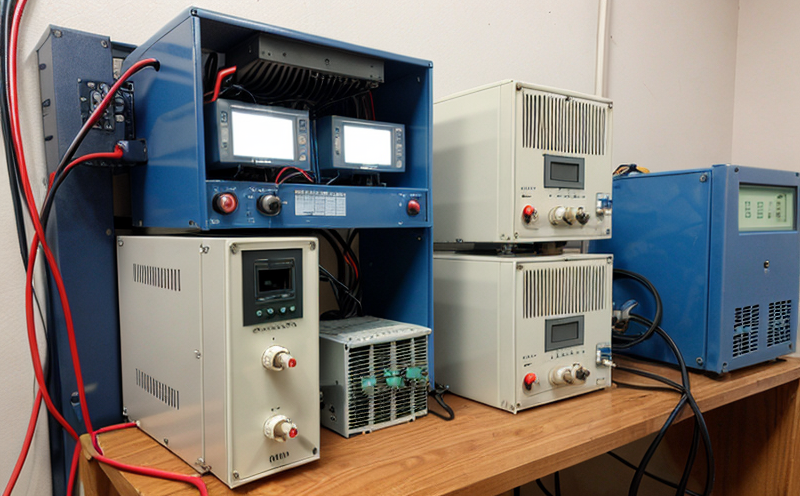ASTM D495 Arc Resistance Testing of Power Supply Components
The ASTM D495 arc resistance testing is a critical procedure used to evaluate the electrical insulation performance of power supply components under arcing conditions. This test is particularly important for ensuring that components in railway and transportation systems can withstand the stresses associated with electrical breakdowns, thus preventing potential failures and hazards.
During an ASTM D495 test, specimens are subjected to high-voltage arcs generated by a spark-gap switch. The objective is to determine how long the specimen remains intact under these conditions without exhibiting signs of damage or failure. This testing ensures that the insulation properties of components meet international standards, which is essential for the safety and reliability of railway equipment.
For power supply components used in railways and transportation systems, the insulating materials must withstand not only normal operating voltages but also the potential stress of arcing. Arcing can occur due to electrical faults or short circuits, leading to serious consequences if not properly managed. ASTM D495 testing helps identify such vulnerabilities early on, allowing for necessary modifications before products are deployed in real-world applications.
The test setup typically involves a specimen placed between two electrodes connected to a high-voltage source and a spark-gap switch. The voltage is gradually increased until arcing occurs across the gap. The duration of arc resistance is then measured. For effective testing, proper sample preparation is crucial; this includes cleaning the specimens thoroughly, ensuring they are dry and free from contamination.
The ASTM D495 standard specifies detailed procedures for conducting these tests, including the type of electrodes used, the voltage range applied, and the duration of exposure to arcing. Compliance with international standards such as ISO 17632-1:2018 or EN 60664-1 ensures that results are comparable across different laboratories worldwide.
Understanding the implications of ASTM D495 testing on railway and transportation systems is essential for quality managers, compliance officers, R&D engineers, and procurement professionals. By ensuring that components meet stringent insulation requirements, these tests contribute significantly to the overall safety and efficiency of railway operations.
- International Acceptance: ASTM D495 has been widely adopted by various international standards organizations, including ISO and EN, making it a globally recognized method for evaluating arc resistance in electrical components.
- Market Impact: Compliance with ASTM D495 is increasingly becoming a requirement for manufacturers aiming to enter the railway and transportation sectors. This standard helps ensure that products meet stringent safety regulations, thereby enhancing market credibility.
Eurolab Advantages
EuroLab offers comprehensive ASTM D495 arc resistance testing services specifically tailored for power supply components in railway and transportation systems. Our state-of-the-art facilities provide the precision and reliability needed to conduct these tests accurately. With experienced technicians and cutting-edge equipment, we ensure that every test meets the highest quality standards.
Our team of experts is well-versed in international standards such as ISO 17632-1:2018 and EN 60664-1, ensuring consistency with global benchmarks. This expertise allows us to provide accurate interpretations and recommendations based on test results. Additionally, our commitment to customer satisfaction ensures that we deliver timely reports and actionable insights.
EuroLab's advanced testing capabilities include the ability to simulate real-world conditions, providing valuable data for R&D teams to refine their products further. Our services are not only focused on compliance but also on helping clients stay ahead of industry trends by offering cutting-edge solutions.
International Acceptance and Recognition
- ISO 17632-1:2018: This international standard has been adopted in many countries, ensuring that ASTM D495 testing is recognized globally. Compliance with these standards guarantees uniformity and reliability across different regions.
- EN 60664-1: European standards like this one are widely followed by manufacturers looking to expand their reach within the EU market. Meeting these requirements enhances a company's reputation and marketability.
The widespread acceptance of ASTM D495 testing underscores its importance in ensuring product safety and reliability. By adhering to international standards, companies can demonstrate their commitment to quality and compliance, thereby gaining competitive advantages in both domestic and export markets.
Competitive Advantage and Market Impact
- Enhanced Safety: Ensuring that power supply components pass ASTM D495 tests can significantly enhance the safety of railway and transportation systems. This reduces the risk of electrical failures, which could lead to accidents or disruptions.
- Innovation: By using ASTM D495 testing as a benchmark for product development, companies can innovate with confidence, knowing that their products meet stringent international standards.
The ability to demonstrate compliance with ASTM D495 and other relevant standards provides a clear competitive edge. It reassures clients about the quality and reliability of components used in critical systems. This trust fosters long-term relationships and opens doors for new business opportunities.
In the highly regulated railway and transportation sector, compliance with international testing methods is not just a requirement but also an opportunity to differentiate oneself from competitors. By embracing these standards, companies can build a strong reputation as leaders in safety and innovation.





